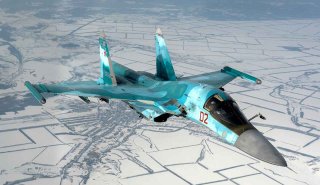Many Western observers have long claimed Russian President Vladimir Putin is on his last legs. Others are claiming that the Russians are about to fold in Ukraine, if only another tranche of weapons and money are sent to the Ukrainians. Yet in the real world, the Russians just launched a series of brutal airstrikes using their Su-34 and Su-35s—two warplanes that have become the punchline in most Western jokes about Russian military technology.
But as Russia’s position in Ukraine is strengthened and the Ukrainian defense is drastically weakened, the joke, unfortunately, appears to be on the West.
The Attack
Using cluster munitions against what Russian state media has described as a Ukrainian “stronghold” in Kursk, a Russian enclave just across the border from Ukraine that Ukrainian forces attacked and have held for several months, the squadron of Su-34s and Su-35s delivered devastating blows upon the Ukrainians as part of Russia’s ongoing counteroffensive there.
The use of the Su-34s is interesting because just recently the United Aircraft Corporation (UAC) delivered a tranche of the warplanes to the Russian Aerospace Forces.
My colleagues at The National Interest, Stavros Altamazoglou and Peter Suciu have both indicated that the Russian defense firm delivered “at least thirty-seven” Su-34 to the Russian Aerospace Forces.
There is much confusion among analysts in the West as to whether Russia is losing more planes and troops than they can field. According to Suciu’s recent article in these pages, “Moscow’s rate of attrition has been outpacing production throughout the ongoing conflict.” Yet Russian forces have essentially maintained a degree of air supremacy over contested regions in the war.
Moscow’s forces could not do that unless they were able to meet the demands for warplanes and other equipment the Ukraine War was placing on their heavily sanctioned defense industrial base. Indeed, even if true, the fact of the matter is that the sprawling complex of defense factories throughout the distant Ural Mountains, in the very heart of the Russian Federation—far outside the range of NATO-provided munitions in Ukraine—is clearly able to consistently produce the planes and equipment Russia’s war efforts requires.
What’s more, the Russians, like their Ukrainian rivals, have innovated truly unorthodox military tactics for overcoming the defenses of their foes in the war. The use of drones and anti-tank weapons, for example, is a great way the two sides have worked around the advantages that traditional armor and air cover usually provides modern militaries. And both Russia and Ukraine have been able to fill whatever gaps their domestic defense industrial bases cannot fill with supplies and support from their respective allies.
Regardless, Suciu reports that the Russians had around “163 operational Su-34s at the start of the conflict” have propagated across the internet in the West. The Su-34 is a real workhorse of the Russian Aerospace Forces, irrespective of its bad press in the West.
Understanding True Russian Capabilities
Fundamentally, the Russians do not need to have systems that are technologically complex the way the Americans and their partners prefer. Instead, Russia just needs systems that are “good enough” to overwhelm the Ukrainians in combat. The Russian way of war has always been nastier than the American way. It tends to work, though.
The Su-34 was designed by the old Soviet Union in the 1980s and was meant to be a multirole strike aircraft. It’s a two-seater, all-weather supersonic bird with twin-engines. Because of the collapse of the Soviet Union, the Su-34 had a hyphenated development period, not seeing deployment until 2000. Officially, the plane entered service in 2014, although there have been claims that the first major combat operations were in Georgia during the Russo-Georgia War in 2008. That has never been confirmed.
Still, the Su-34 is a plane that has consistently delivered, despite being perennially underestimated by its rivals in the West. Such a mentality is unfortunate because one should never underestimate their rivals. The recent airstrikes conducted by Russia’s Su-34s were a reminder that the Russian war machine continues chugging along.
That’s not a put down of the Ukrainians who are fighting with everything they have (and everything NATO gives them). It’s a simple reality: the Russians are skilled practitioners of the bloody art of attritional warfare.
Brandon J. Weichert, a Senior National Security Editor at The National Interest as well as a Senior Fellow at the Center for the National Interest, and a contributor at Popular Mechanics, consults regularly with various government institutions and private organizations on geopolitical issues. Weichert’s writings have appeared in multiple publications, including the Washington Times, National Review, The American Spectator, MSN, the Asia Times, and countless others. His books include Winning Space: How America Remains a Superpower, Biohacked: China’s Race to Control Life, and The Shadow War: Iran’s Quest for Supremacy. His newest book, A Disaster of Our Own Making: How the West Lost Ukraine is available for purchase wherever books are sold. He can be followed via Twitter @WeTheBrandon.
Image: Wikimedia Commons.

